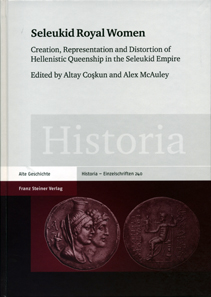by Ursula Kampmann
translated by Christina Schlögl
October 27, 2016 – It was the image on the cover, that led me to order the records of the congress “Seleukid Royal Women”. It showed a coin with Alexander Balas and his wife, whose name I have of course forgotten again, on the obverse. Traditionally you rarely stumble upon the names of queens in historian circles… Nevertheless, this woman – Cleopatra Thea, for all those who, like me, have forgotten the name – must have played an important role in her husband’s concept of power. There is no other way to explain her presence on the effigy. The different essays in this publication by the publishing house Franz Steiner deal with her role and with how she developed it after Alexander the Great had died. Many of these essays are also of interest to numismatists. Or at least to numismatists, who do not only care about the rarity, condition and price of a coin, but are also interested in the historical background.
Seleukid Royal Women Creation, Representation and Distortion of Hellenistic Queenship in the Seleukid Empire A. Coskun und A. McAuley (Ed.). Franz Steiner Verlag, Stuttgart 2016. 322 p. with several b/w img. Paperback, stitchbinding. 17.5 x 24.5 cm. ISBN 978-3-515-11295-6. 62 euros.
Because even though we have numerous written and epigraphic sources on the Hellenistic Period, numismatics is still a very significant source for this period and three of the twelve contributions in this volume rely on numismatic sources.
The publication consists of four parts. At first, the editors introduce the subject and Hans Beck provides the framework, so to speak, by looking at aristocratic women in China, Rome and in between.
The second part picks up the subject of the first phase of the Seleucid dynasty, when the role of a Seleucid Basilissa, next to the Basileus was created. It revolves around Apame and Stratonice, around the Iranian woman, who married by command of Alexander during the mass wedding of Susa, and around Stratonice of Syria, daughter of Demetrius I of Macedon and granddaughter of Antipater II of Macedon.
Ann-Cathrin Harders starts us off. She analyses, how Seleucus I made both women queen, how the public reacted to them and what we know about the dealings of Apame and Stratonice.
David Engels and Kyle Erickson show, what a significant role the two queens played in the development of the Seleucid ideology. This is where numismatics comes in. The authors create a link between the depiction of Artemis steering an elephant biga on extremely rare gold starters of Seleucus I and the person of Stratonice of Syria. Zeus would thus stand for Seleucus on the effigy, Apollo for Antiochus I and Artemis accordingly for Stratonice.
Eran Almagor interprets a strange story, recorded by several authors: Stratonice was actually supposed to marry Seleucus himself. But when his son Antiochus fell in love with her, the father wisely gave her to the son. Almagor suggests that Seleucus was following an Achaemenid custom that acknowledged the son as successor of the father by handing over a woman.
Gillian Ramsey closes the first part with a study on the self-representation of Apame and Stratonice to the Greek public.
The third part deals with two later ruling women, namely Laodice I, who some authors have made responsible for the outbreak of the third Syrian war and whose bad reputation Altay Coskun puts in the right light, while Brett Barlett occupies herself with the fate of Tryphaena, the sister-wife of Antiochus VIII.
The last contribution is important for numismatics. Sheila Ager and Creig Hardiman ask questions about portraits of female Seleucids. Naturally, numismatics plays an important part here, but the authors have also considered epigraphic sources.
The fourth part takes a look at the neighbourhood, Cyrene (Alex McAuley), Commagene (Rolf Strootman) and the Hasmonean Kingdom (Julia Wilker). The contributions of Richard Wenhofer and Del John Houle are of numismatic interest as they deal with the marriage diplomacy of the Seleucids and several Greco-Bactrian mints.
Adrian Dumitru makes Cleopatra Selene the centre of his considerations. We only know this queen’s through three bronze denominations. But the author provides a table, in which he contrasts the traditional times of reign of the late Seleucid dynasty with the new times of reign, adjusted according to new coin dating.
All in all this collection is not an absolute must for every numismatic library, but specialized collectors of Seleucid coins should definitely consider buying it. Not only will you be provided with current research, but you will also find out a lot about subjects that have rarely been covered by the literature so far.
You can directly order the book at Steiner publishing house.
It is also available as an eBook.





